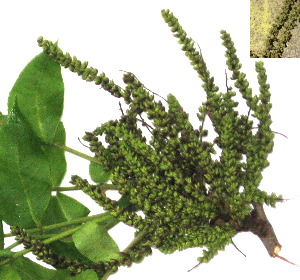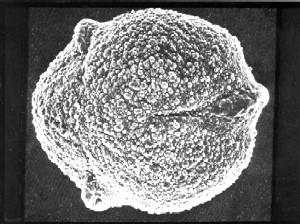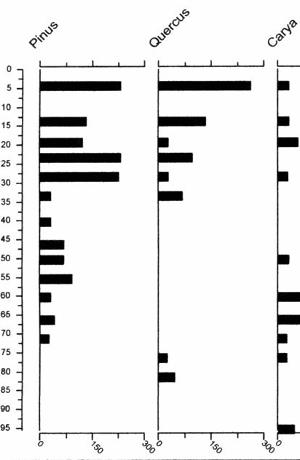Pollen Analysis
Palynology is the microscopic study of pollen grains and spores, the fine powdery material produced on the stamens and anthers of seed plants. The grains are minute in size, each ranging from 15 to 100 microns. To understand the scale, consider that the head of a pin is about 2 mm (2000 microns) in diameter. Just a pinch of pollen powder contains thousands of grains. Because each pollen type has a unique set of attributes (size, shape, and characteristics of the outer wall), analysts can usually identify the species or plant family from which it originated.
Pollen collected from an archeological site can provide insights into what the overall environment was like at the time the site was occupied and how area vegetation changed through time. Samples can be derived both from cultural and non-cultural settings when reconstructing plant communities. In Texas, however, pollen outside of wet bogs is generally poorly preserved.
Methods
Chemical extraction of pollen samples was conducted at the Palynology Laboratory at Texas A&M University using a procedure designed for semi-arid Southwestern sediments. The method, detailed below, specifically avoids use of such reagents as nitric acid and bleach, which have been experimentally demonstrated to be destructive to pollen grains. The methods and results below are based on the report by Richard Holloway at Quaternary Services.
Fifteen grams (g) of soil were sub-sampled from each sample submitted. Prior to chemical extraction, two tablets of concentrated Lycopodium spores, marker grains, were added to each sub-sample. The addition of marker grains permits calculation of pollen concentration values and provides an indicator for accidental destruction of pollen during the laboratory procedure.
The samples were treated with 35 percent Hydrochloric Acid (HCl) overnight to remove carbonates and to release the Lycopodium spores from their matrix. After neutralizing the acid with distilled water, the samples were allowed to settle for a period of at least three hours before the supernatant liquid was removed. Additional distilled water was added to the supernatant, and the mixture was swirled and then allowed to settle for 5 seconds. The suspended fine fraction was decanted through very, very fine mesh screen into a second beaker. This procedure, repeated at least three times, removed lighter materials, including pollen grains, from the heavier fractions. The fine material was concentrated by centrifuging at 2,000 revolutions per minute (RPM). Read more
Findings of Pollen Analysis
The results indicate that the pollen assemblages from this site were generally poorly preserved. Pine (Pinus sp.) pollen (wind dispersed), was present throughout the column in very low concentration values. Pine pollen was deposited through long distance transport. Although pine was noted in the modern vegetation, the concentration values indicate that its presence was minimal. The absence of juniper pollen from these assemblages is thought to be a function of preservation. Juniper (Juniperus) is common in the modern vegetation of the area. But this pollen grain is thin walled and generally poorly preserved. Thus, its absence even from locales containing abundant Juniper plants is not unexpected.
Oak (Quercus), hickory and pecan (Carya), and walnut (Juglans) pollen were present throughout the column. Walnut pollen was restricted to the Toyah component and was quite rare. The presence of these woods indicates similar vegetational composition from the Early Archaic (at least 6200 B.P.) through the more recent Toyah component (roughly 300 B.P.). The variations in the pollen concentration values are likely a function of the weathering of the assemblages.
The upper levels of the column, representing the Toyah component (300 to 650 B.P.) and extending possibly to the upper level of the Late Archaic (1700 to 2300 B.P.) are characterized by high concentration values of Cheno-am, Asteraceae, and Poaceae (grass family). These indicate a mosaic pattern of grassland components interspersed with the arboreal trees and shrubs. The slight increase in Poaceae pollen concentration values from the Early Archaic period may indicate an increase in grasses during this early time period. It is also suggestive of the effects of weathering. In particular, the decrease in Cheno-am and Asteraceae pollen concentration values during the Early Archaic period is probably indicative of poor preservation.
There is also some indication of the presence of more riparian communities within the area throughout the time periods represented. Particularly, this is indicated by the presence of Apiaceae (umbel or carrot family) pollen concentration values from both the Toyah and the Early Archaic periods. The evidence from the Early Archaic was present in the low magnification scan of the slide only. Members of the Apiaceae Family are generally found in more moist conditions, possibly along the banks of Hackberry Creek. Walnut pollen was present only in the Toyah component. Hickory and pecan pollen were present from the Toyah component as well as from the Early, Middle, and Late Archaic deposits. Interestingly, hickory and pecan pollen are restricted to the Early Archaic deposits from the dated section samples. Hickory, pecan,and walnut generally require a more dependable water source and are thus often indicators of more riparian conditions. The presence of Hackberry Creek in close proximity to the site, although intermittent, probably provided the necessary moisture requirements for these trees, throughout both the Archaic and the Toyah component.
The pollen from the Toyah component is consistent with the modern vegetation of the area. The Late Archaic pollen (1,700 to 2,300 B.P.) reflects the same pollen as present during the Toyah component. In the Middle Archaic (3,900 to 4,800 B.P.), low spine Asteraceae tends to increase in concentration values, whereas all other taxa show decreases. This, coupled with the very low occurrences of non-Opuntia Cactaceae (cactus family)and Ephedra, hint at drier conditions during this period. In the Early Archaic component (6,300 to 5,200 B.P.), the low arboreal pollen concentration values might indicate a relatively dry climate, with decrease in the arboreal cover and a concomitant expansion of meadow-like communities.
|
Pollen analysis addresses questions such as:
|

|

Example of an oak (Quercus) pollen grain, at high magnification (Scanning Electron Microscope, SEM). Image from www.pollenuk.co.uk.

|

|